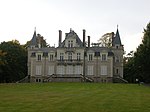Hall XXL
2013 establishments in France21st-century architecture in FranceFrench sports venue stubsHandball venues in FranceIndoor arenas in France ... and 4 more
Music venues completed in 2013Music venues in FranceSports venues completed in 2013Sports venues in Nantes
Hall XXL is a multi-purpose indoor arena in Nantes, France. Opened in August 2013, the arena is mainly used for exhibitions and sporting events.
Excerpt from the Wikipedia article Hall XXL (License: CC BY-SA 3.0, Authors).Hall XXL
Avenue de Normandie, Nantes Nantes Erdre
Geographical coordinates (GPS) Address Nearby Places Show on map
Geographical coordinates (GPS)
| Latitude | Longitude |
|---|---|
| N 47.258437 ° | E -1.532571 ° |
Address
Grand Palais
Avenue de Normandie
44300 Nantes, Nantes Erdre
Pays de la Loire, France
Open on Google Maps





